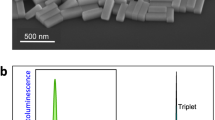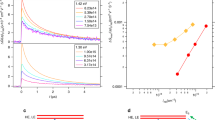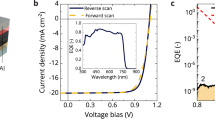Abstract
Solar cells based on the organic–inorganic tri-halide perovskite family of materials have shown significant progress recently, offering the prospect of low-cost solar energy from devices that are very simple to process. Fundamental to understanding the operation of these devices is the exciton binding energy, which has proved both difficult to measure directly and controversial. We demonstrate that by using very high magnetic fields it is possible to make an accurate and direct spectroscopic measurement of the exciton binding energy, which we find to be only 16 meV at low temperatures, over three times smaller than has been previously assumed. In the room-temperature phase we show that the binding energy falls to even smaller values of only a few millielectronvolts, which explains their excellent device performance as being due to spontaneous free-carrier generation following light absorption. Additionally, we determine the excitonic reduced effective mass to be 0.104me (where me is the electron mass), significantly smaller than previously estimated experimentally but in good agreement with recent calculations. Our work provides crucial information about the photophysics of these materials, which will in turn allow improved optoelectronic device operation and better understanding of their electronic properties.
This is a preview of subscription content, access via your institution
Access options
Subscribe to this journal
Receive 12 print issues and online access
$209.00 per year
only $17.42 per issue
Buy this article
- Purchase on Springer Link
- Instant access to full article PDF
Prices may be subject to local taxes which are calculated during checkout




Similar content being viewed by others
References
Best research cell efficiencies. NREL (2015); http://www.nrel.gov/ncpv/images/efficiency_chart.jpg
Kim, H-S. et al. Lead iodide perovskite sensitized all-solid-state submicron thin film mesoscopic solar cell with efficiency exceeding 9%. Sci. Rep. 2, 591 (2012).
Burschka, J. et al. Sequential deposition route to high performance perovskite-sensitized solar cells. Nature 499, 316–320 (2013).
Im, J-H., Lee, C-R., Lee, J-W., Park, S-W. & Park, N-G. 6.5% efficient perovskite quantum-dot-sensitized solar cell. Nanoscale 3, 4088–4093 (2011).
Heo, J. H. et al. Efficient inorganic–organic hybrid heterojunction solar cells containing perovskite compound and polymeric hole conductors. Nature Photon. 7, 487–492 (2013).
Lee, M. M., Teuscher, J., Miyasaka, T., Murakami, T. N. & Snaith, H. J. Efficient hybrid solar cells based on meso-superstructured organometal halide perovskites. Science 338, 643–647 (2012).
Liu, M., Johnston, B. M. & Snaith, H. J. Efficient planar heterojunction perovskite solar cells by vapour deposition. Nature 501, 395–398 (2013).
Wang, J. T-W. et al. Low-temperature processed electron collection layers of graphene/TiO2 nanocomposites in thin-film perovskite solar cells. Nano Lett. 14, 724–730 (2014).
Habisreutinger, S. N. et al. Carbon nanotube/polymer composites as a highly stable hole collection layer in perovskite solar cells. Nano Lett. 14, 5561–5568 (2014).
Jung, H. S. & Park, N-G. Perovskite solar cells: From materials to devices. Small 11, 10–25 (2015).
D’Innocenzo, V. et al. Excitons versus free charges in organo-lead tri-halide perovskites. Nature Commun. 5, 3586 (2013).
Hirasawa, M., Ishihara, T., Goto, T., Ushida, K. & Miura, N. Magnetoabsorptin of the lowest exciton in perovskite-type compound (CH3NH3)PbI3 . Physica B 201, 427–430 (1994).
Tanaka, K. et al. Comparative study on the excitons in lead-halide-based perovskite-type crystals CH3NH3PbBr3 CH3NH3PbI3 . Solid State Commun. 127, 619–623 (2003).
Menendez-Proupin, E., Palacios, P., Wahnon, P. & Conesa, J. C. Self-consistent relativistic band structure of the CH3NH3PbI3 perovskite. Phys. Rev. B 90, 045207 (2014).
Even, J., Pedesseau, L. & Katan, C. Analysis of multi-valley and multi-bandgap absorption and enhancement of free carriers related to exciton screening in hybrid perovskites. J. Phys. Chem. C 118, 11566–11572 (2014).
Yamada, Y., Nakamura, T., Endo, M., Wakamiya, A. & Kanemitsu, Y. Photoelectronic responses in solution-processed perovskite CH3NH3PbI3 solar cells studied by photoluminescence and photoabsorption spectroscopy. IEEE J. Photovolt. 5, 401–405 (2015).
Lin, Q., Armin, A., Nagiri, R. C. R., Burn, P. L. & Meredith, P. Electro-optics of perovskite solar cells. Nature Photon. 9, 106–112 (2014).
Umari, P., Mosconi, E. & De Angelis, F. Relativistic GW calculations on CH3NH3PbI3 and CH3NH3SnI3 perovskites for solar cell applications. Sci. Rep. 4, 4467 (2014).
Baikie, T. et al. Synthesis and crystal chemistry of the hybrid perovskite (CH3NH3)PbI3 for solid-state sensitised solar cell applications. J. Mater. Chem. A 1, 5628–5641 (2013).
Fang, H-H. et al. Photophysics of organic-inorganic hybrid lead iodide perovskite single crystals. Adv. Funct. Mater. 25, 2378–2385 (2015).
Makado, P. C. & McGill, N. C. Energy levels of a neutral hydrogen-like system in a constant magnetic field of arbitrary strength. J. Phys. C 19, 873–885 (1986).
Watanabe, K., Uchida, K. & Miura, N. Magneto-optical effects observed for GaSe in megagauss magnetic fields. Phys. Rev. B 68, 155312 (2003).
Weiler, M. H., Aggarwal, R. L. & Lax, B. Warping and inversion asymmetry induced cyclotron harmonic transitions in InSb. Phys. Rev. B 17, 3269–3283 (1979).
Brivio, F., Butler, K. T., Walsh, A. & van Schilfgaarde, M. Relativistic quasiparticle self-consistent electronic structure of hybrid halide perovskite photovoltaic absorbers. Phys. Rev. B 89, 155204 (2014).
Wehrenfennig, C., Liu, M., Snaith, H. J., Johnston, M. B. & Herz, L. M. Charge carrier dynamics in vapour-deposited films of the organolead halide perovskite CH3NH3PbI3−xClx . Energ. Environ. Sci. 7, 2269–2275 (2014).
Wehrenfennig, C., Liu, M., Snaith, H. J., Johnston, M. B. & Herz, L. M. Charge carrier recombination channels in the low-temperature phase of organic–inorganic lead halide perovskite thin films. APL Mater. 2, 081513 (2014).
Huang, L-Y. & Lambrecht, W. R. L. Electronic band structure, phonons, and exciton binding energies of halide perovskites CsSnCl3, CsSnBr3, and CsSnI3 . Phys. Rev. B 88, 165203 (2013).
Chena, Z. et al. Photoluminescence study of polycrystalline CsSnI3 thin films: Determination of exciton binding energy. J. Lumin. 132, 345–349 (2012).
Ponseca, C. S. et al. Organometal halide perovskite solar cell materials rationalized: Ultrafast charge generation, high and microsecond-long balanced mobilities, and slow recombination. J. Am. Chem. Soc. 136, 5189–5192 (2014).
Wehrenfennig, C., Eperon, G. E., Johnston, M. B., Snaith, H. J. & Herz, L. M. High charge carrier mobilities and lifetimes in organolead trihalide perovskites. Adv. Mater. 26, 1584–1589 (2013).
Dvorak, M., Wei, S-H. & Wu, Z. Origin of the variation of exciton binding energy in semiconductors. Phys. Rev. Lett. 110, 016402 (2013).
Nie, W. et al. High-efficiency solution-processed perovskite solar cells with millimeter-scale grains. Science 347, 522–525 (2015).
Nicholas, R. J., Solane, P. Y. & Portugall, O. Ultra-high magnetic field study of the layer split bands in graphite. Phys. Rev. Lett. 111, 096802 (2013).
Portugall, O. et al. Megagauss magnetic fields in single-turn coils: New frontiers for scientific experiments. J. Phys. D 32, 2354–2366 (1999).
Acknowledgements
The authors thank: Meso-superstructured Hybrid Solar Cells—MESO NMP-2013-SMALL7-604032 project. H.J.S. thanks for financial support the Engineering and Physical Sciences Research Council (EPSRC), and the European Research Council (ERC-StG 2011 HYPER Project no. 279881). S. Stranks thanks Worcester College, Oxford, for additional financial support. P.P. thanks ANR JCJC project milliPICS, Region Midi-Pyrenee contract MESR 13053031. A. Miyata thanks the JSPS postdoctoral fellowships for research abroad for support. This work was supported by EuroMagNETII under the EU contract No. 228043.
Author information
Authors and Affiliations
Contributions
A.Miyata, A.Mitioglu, P.P., O.P. and R.J.N. collected and analysed the data. J.T-W.W. and S.D.S. prepared the samples. All authors contributed to the interpretation and the manuscript preparation. R.J.N. supervised and initiated the project.
Corresponding author
Ethics declarations
Competing interests
The authors declare no competing financial interests.
Rights and permissions
About this article
Cite this article
Miyata, A., Mitioglu, A., Plochocka, P. et al. Direct measurement of the exciton binding energy and effective masses for charge carriers in organic–inorganic tri-halide perovskites. Nature Phys 11, 582–587 (2015). https://doi.org/10.1038/nphys3357
Received:
Accepted:
Published:
Issue Date:
DOI: https://doi.org/10.1038/nphys3357
This article is cited by
-
Methods and applications of machine learning in computational design of optoelectronic semiconductors
Science China Materials (2024)
-
Efficient flexible perovskite solar cells and modules using a stable SnO2-nanocrystal isopropanol dispersion
Nano Research (2024)
-
Recent advances in halide perovskite memristors: From materials to applications
Frontiers of Physics (2024)
-
Optimizing lead-free Cs3Bi2I9 perovskite solar cells: exploring absorber and charge transport layers parameters for improved efficiency
Journal of Optics (2024)
-
Interfacial modification in perovskite-based tandem solar cells
Nano Convergence (2023)



